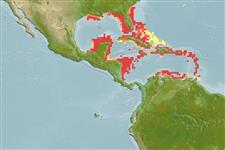Environment: milieu / climate zone / depth range / distribution range
Ecología
marino; rango de profundidad 0 - 50 m (Ref. 189). Tropical; 32°N - 10°N, 94°W - 60°W (Ref. 189)
Western Central Atlantic: Beaufort, North Carolina south to Florida (USA); Antilles from Cuba to St. Lucia, also Trinidad, but not recorded at Blanquilla and Los Roques off Venezuela; also occurs off Panama.
Tamaño / Peso / Age
Maturity: Lm ? range ? - ? cm
Max length : 11.0 cm TL macho / no sexado; (Ref. 5217); common length : 9.0 cm TL macho / no sexado; (Ref. 5217)
Espinas dorsales (total) : 0; Radios blandos dorsales (total) : 15 - 16; Espinas anales: 0; Radios blandos anales: 10 - 18. Body slightly compressed; snout moderate, about 3/4 eye diameter; maxilla short with bluntly rounded tip, failing to reach pre-operculum by 1/2 pupil diameter; pseudobranch short, about 3/4 eye diameter; panamensis-type gill cover canals. Anal fin origin slightly behind base of last dorsal fin ray. A bright silver stripe along flank, about 3/4 or almost equal to eye, dark bordered above (Ref. 189). Body pale, few melanophores above, row of anal melanophores along anal-fin base. Eye orangish above, top of head with green and gold reflections (Ref. 7251).
Occurs in coastal waters, apparently not entering brackish water. Rare in Florida shore seine collections, but 'in great numbers under a night light', perhaps because it may stay some distance from the shore in daytime.
Life cycle and mating behavior
Maturities | Reproducción | Spawnings | Egg(s) | Fecundities | Larva
Spawn in school (Ref. 205).
Whitehead, P.J.P., G.J. Nelson and T. Wongratana, 1988. FAO Species Catalogue. Vol. 7. Clupeoid fishes of the world (Suborder Clupeoidei). An annotated and illustrated catalogue of the herrings, sardines, pilchards, sprats, shads, anchovies and wolf-herrings. FAO Fish. Synop. 125(7/2):305-579. Rome: FAO. (Ref. 189)
IUCN Red List Status (Ref. 130435)
Threat to humans
Harmless
Human uses
Pesquerías: pesquerías de subsistencia; carnada: usually
Herramientas
Special reports
Download XML
Fuentes de Internet
Estimates based on models
Preferred temperature (Ref.
123201): 23.4 - 28, mean 26.4 °C (based on 226 cells).
Phylogenetic diversity index (Ref.
82804): PD
50 = 0.5000 [Uniqueness, from 0.5 = low to 2.0 = high].
Bayesian length-weight: a=0.00537 (0.00253 - 0.01141), b=3.13 (2.96 - 3.30), in cm total length, based on LWR estimates for this (Sub)family-body shape (Ref.
93245).
Nivel trófico (Ref.
69278): 3.2 ±0.4 se; based on size and trophs of closest relatives
Resiliencia (Ref.
120179): Alto, población duplicada en un tiempo mínimo inferior a 15 meses (Preliminary K or Fecundity.).
Fishing Vulnerability (Ref.
59153): Low vulnerability (10 of 100).
